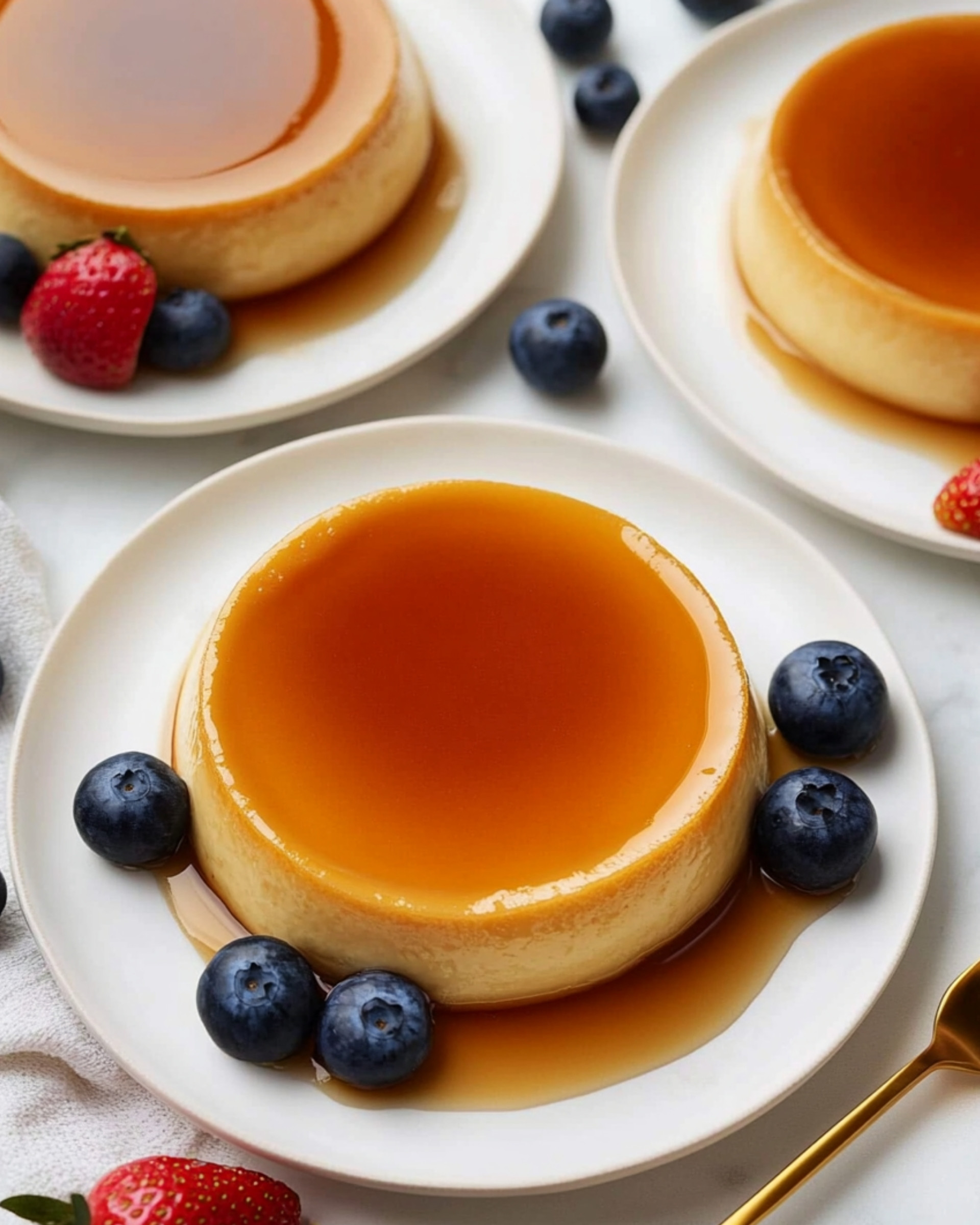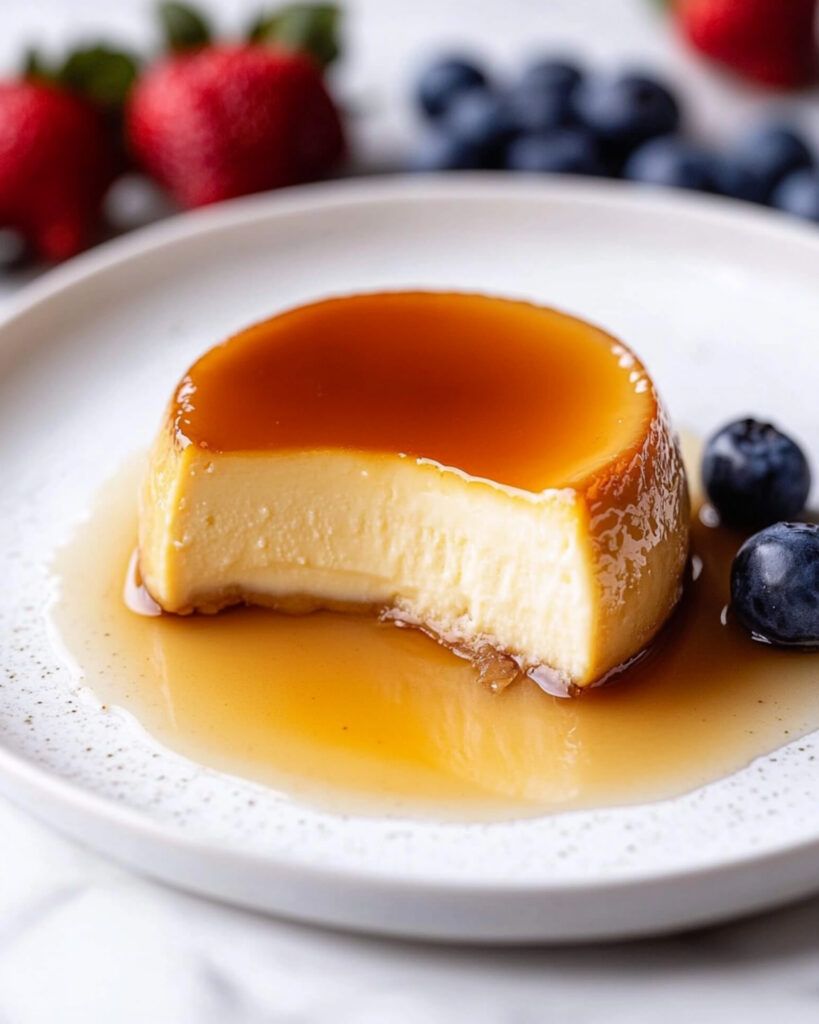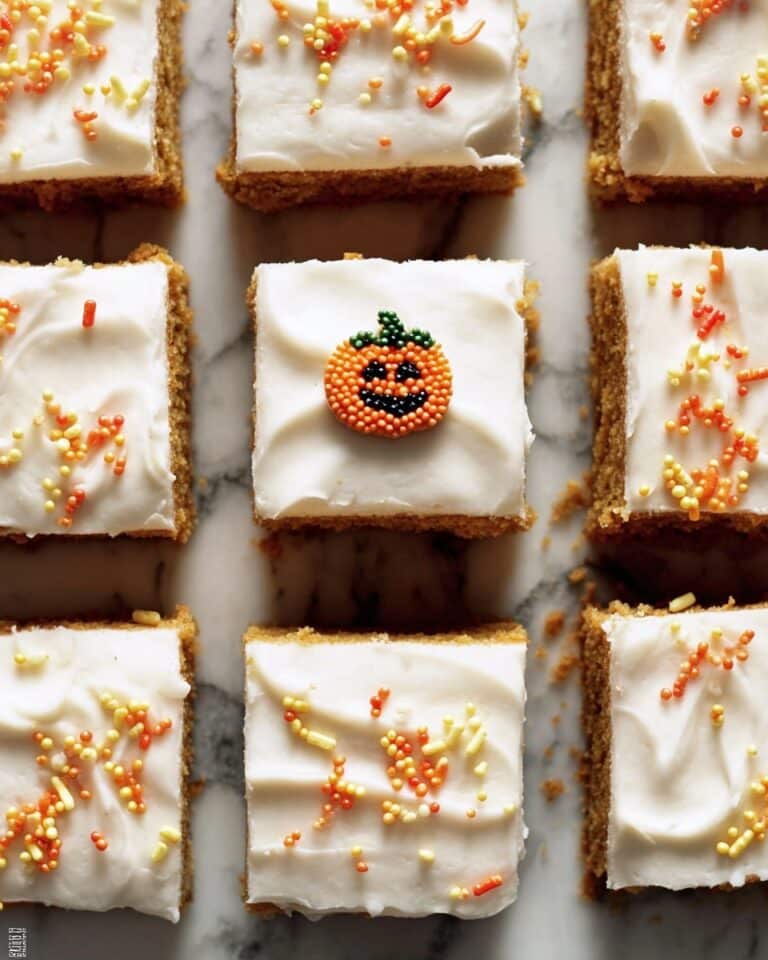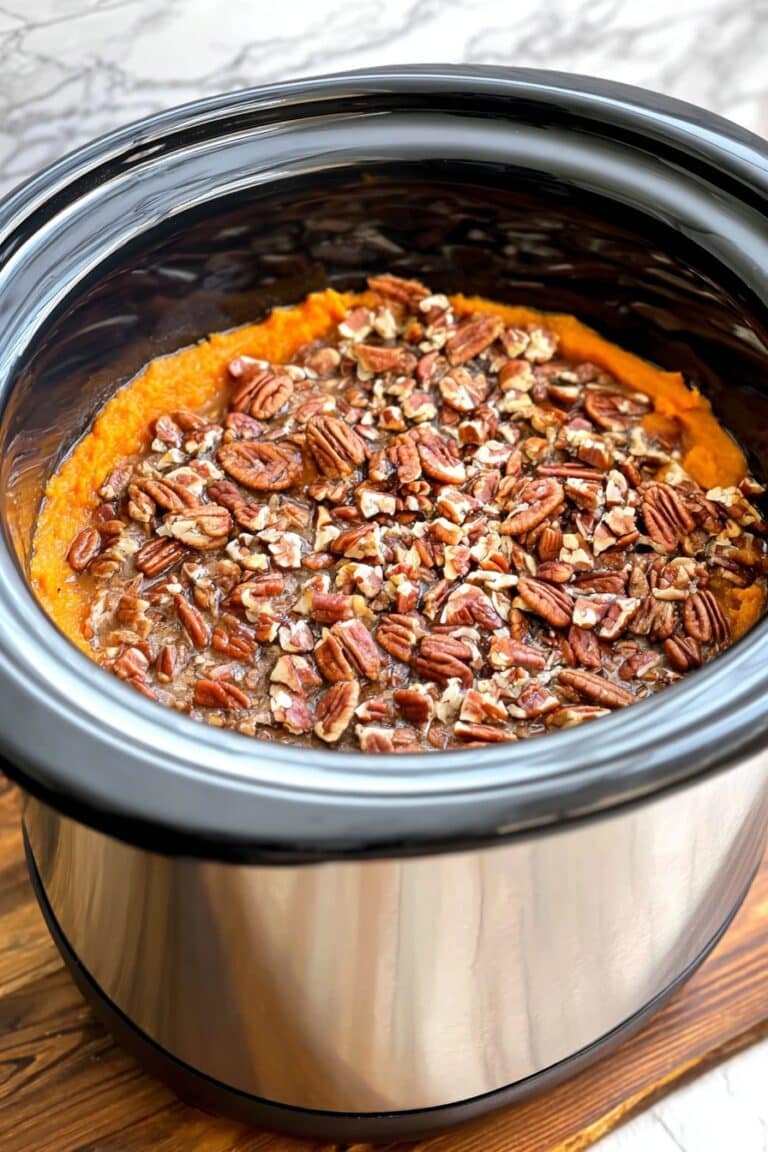This Classic Creme Caramel is pure, unadulterated magic in dessert form. With its silky-smooth custard and amber caramel sauce that cascades down the sides when inverted, this elegant yet surprisingly simple dessert will transport you straight to a French bistro. The best part? It requires just a handful of everyday ingredients to create something truly extraordinary!
Why You’ll Love This Recipe
- Impressive yet simple: Despite its fancy restaurant appearance, this dessert is remarkably straightforward to make at home.
- Make-ahead friendly: Perfect for entertaining since it needs to chill for several hours, allowing you to prepare it well before guests arrive.
- Luxurious texture: The custard has an incredibly silky, melt-in-your-mouth consistency that makes each bite pure bliss.
- Balanced flavors: The bitter-sweet caramel perfectly complements the rich, vanilla-infused custard for a dessert that isn’t overly sweet.
Ingredients You’ll Need
- Sugar: The star player in creating that gorgeous amber caramel that transforms into a sauce when inverted. You’ll need it for both the caramel and the custard.
- Water: Just a splash to help the sugar melt evenly as it caramelizes.
- Whole milk or evaporated milk: Provides the creamy base for your custard. Whole milk creates a lighter texture, while evaporated milk produces a richer result.
- Vanilla extract: Adds that warm, aromatic flavor that elevates the custard. Real vanilla extract makes a noticeable difference here.
- Salt: Just a pinch enhances all the flavors and balances the sweetness perfectly.
- Eggs and egg yolks: The structural foundation of your custard, providing both richness and that signature silky texture. The extra yolks add an indulgent creaminess.
Note: You’ll find the complete list of ingredients, along with their exact measurements, in the printable recipe card at the bottom of this post.
Variations
Flavor Infusions
Infuse the milk with different flavors like cinnamon sticks, cardamom pods, coffee beans, or orange zest before making the custard.
Coconut Creme Caramel
Replace the whole milk with coconut milk for a tropical twist that pairs beautifully with fresh mango.
Chocolate Variation
Add 2 ounces of melted dark chocolate to the custard mixture for a chocolate lover’s dream.
Individual vs. Family Style
Make one large creme caramel in a 9-inch cake pan instead of individual ramekins for a dramatic presentation at dinner parties.
How to Make Classic Creme Caramel
Step 1: Prepare Your Equipment
Preheat your oven to 300°F. Arrange 6 ramekins in a 9×13 inch baking dish, which will serve as your water bath later.
Step 2: Create the Caramel
Combine sugar and water in a small saucepan over medium heat. This is where patience pays off – resist the urge to stir constantly! Allow the mixture to cook for 10-12 minutes until it transforms into a rich amber color. Then quickly divide this molten gold among your ramekins and let it cool.
Step 3: Prepare the Custard Base
Heat your milk in a separate saucepan, stirring frequently to prevent it from scorching. Once it reaches a gentle simmer, remove from heat and whisk in sugar, vanilla, and salt until completely dissolved.
Step 4: Add the Eggs
In a separate bowl, whisk together eggs and egg yolks until well combined. Now comes the crucial part: slowly incorporate the egg mixture into the warm milk mixture, adding just a little at a time while whisking constantly. This gradual approach prevents the eggs from scrambling.
Step 5: Assemble and Bake
Pour your silky custard mixture evenly into the caramel-lined ramekins. Create a water bath by carefully pouring hot water into the baking dish until it reaches about ¾ up the sides of the ramekins. Bake for 40-45 minutes until set but still slightly jiggly in the center.
Step 6: Cool and Chill
Remove the ramekins from the water bath and allow them to cool completely at room temperature. Then refrigerate for 3-4 hours or overnight until thoroughly chilled and set.
Step 7: The Grand Finale
When ready to serve, run a knife around the edge of each custard, place a serving plate on top, and confidently flip it over. The custard should release with the caramel sauce flowing gloriously over the top and sides.
Pro Tips for Making the Recipe
- Watch the caramel carefully: It can go from perfect to burnt in seconds. Look for a deep amber color – not too light (it’ll be bland) or too dark (it’ll taste bitter).
- Strain your custard: For the silkiest texture, pass the custard mixture through a fine mesh sieve before pouring into ramekins.
- The water bath is non-negotiable: It ensures gentle, even cooking that prevents the custard from curdling or developing a rubbery texture.
- The jiggle test: The center should still have a slight wobble when you remove it from the oven – it will continue to set as it cools.
- Caramel troubleshooting: If your caramel hardens before you can pour it, gently reheat it until fluid again.
How to Serve

Classic Presentation
Serve your creme caramel on its own, allowing the simplicity of the dessert to shine. A small sprig of mint adds a beautiful color contrast.
Fruit Pairings
Fresh berries, sliced mango, or poached pears complement the custard beautifully without overwhelming its delicate flavor.
Textural Contrast
A light sprinkle of crushed toasted pistachios or almond slivers around the plate adds a delightful crunch.
Beverage Pairings
A small glass of Sauternes, late-harvest Riesling, or even a good espresso makes for a perfect accompaniment.
Make Ahead and Storage
Make Ahead
This dessert actually improves with time! Make it up to 2 days ahead of when you plan to serve – the caramel continues to infuse into the custard, developing even more complex flavors.
Storing Leftovers
Cover individual ramekins with plastic wrap and refrigerate for up to 4 days. The caramel may continue to dissolve into the custard, creating more sauce.
Freezing
Creme caramel doesn’t freeze well as the texture becomes grainy upon thawing, so it’s best enjoyed fresh.
Reheating
This dessert is served cold and should not be reheated. Simply remove from the refrigerator about 15 minutes before serving to take the chill off.
FAQs
-
Why did my caramel crystallize and become grainy?
Crystallization typically happens when sugar crystals form on the sides of the pan and fall back into the mixture. Avoid this by not stirring once the sugar starts to dissolve, instead gently swirling the pan. A splash of lemon juice or corn syrup can also help prevent crystallization.
-
Can I use low-fat milk instead of whole milk?
While you can use low-fat milk, the custard won’t be as rich or creamy. The fat in whole milk contributes significantly to the luxurious texture that makes creme caramel so special. If watching calories, I’d suggest enjoying a smaller portion of the full-fat version rather than compromising on flavor.
-
Why does my custard have bubbles or holes in it?
Bubbles usually occur when the custard mixture is poured too quickly into the ramekins, trapping air. To prevent this, pour slowly and consider letting the mixture rest for a few minutes to allow bubbles to rise to the surface. You can also tap the ramekins gently against the counter to release trapped air.
-
How can I tell when my creme caramel is perfectly done?
The custard should be set around the edges but still have a slight jiggle in the center – similar to Jell-O. A knife inserted near the center should come out clean, but the very center might still be a bit wobbly. Remember, it will continue to set as it cools.
Final Thoughts
This Classic Creme Caramel brings together simple ingredients to create a truly extraordinary dessert. It’s the perfect recipe to keep in your repertoire for those occasions when you want to impress without spending hours in the kitchen. The joy of watching that caramel sauce cascade down the sides of the perfectly set custard never gets old – and trust me, neither does the taste. Give this timeless dessert a try and discover why it has remained a beloved classic for generations!
Print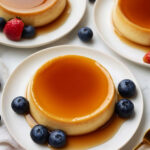
Classic Creme Caramel Recipe
- Prep Time: 5 minutes
- Cook Time: 1 hour
- Total Time: 4 hours 5 minutes
- Yield: 6 Servings
- Category: Desserts
- Method: Baking
- Cuisine: French
- Diet: Vegetarian
Description
Classic Creme Caramel, a luscious and smooth dessert with a rich caramel topping and silky custard base, is the perfect treat to impress your guests or indulge in a sweet craving.
Ingredients
For the Caramel Sauce:
- 1 1/2 cups sugar
- 2 tablespoons water
For the Custard:
- 2 1/2 cups whole milk, or evaporated milk
- 1/3 cup granulated sugar
- 1 teaspoon vanilla extract
- Pinch of salt
- 3 whole eggs
- 2 egg yolks
Instructions
- Preheat and prepare ramekins: Preheat the oven to 300°F. Place 6 ramekins in a 9×13 inch baking dish, and set aside.
- Prepare the caramel sauce: Make the caramel sauce by placing the sugar and water in a small saucepan, heating over medium heat for several minutes. Stir the mixture and continue to cook until it turns a rich, brown caramel color (this will take 10 – 12 minutes).
- Pour caramel into ramekins: Pour the caramel sauce into the ramekins, dividing as evenly as possible. Be careful, as the sauce will be very hot. Allow it to cool.
- Heat the milk: While the caramel sauce is cooling, place the milk in another saucepan over medium heat. Stir often to prevent scorching, as the milk heats. Once it reaches a simmer, remove the milk from the heat.
- Mix custard ingredients: Stir the sugar, vanilla, and salt into the milk, whisking until dissolved. In a separate bowl, whisk the eggs and egg yolks together until well-blended. Then whisk the egg mixture into the milk mixture, working a little bit at a time, to keep the eggs from scrambling. This is the custard base of the creme caramel.
- Pour custard into ramekins: Pour the custard mixture into the ramekins, dividing as evenly as possible.
- Prepare the water bath: Transfer the baking pan with the ramekins inside to the oven. Carefully pour hot water into the pan around the ramekins, for the water bath. You want the water to rise about ¾ the way up the sides of the ramekins.
- Bake the creme caramel: Bake for 40 to 45 minutes, or until a toothpick inserted into the center of the custard comes out clean.
- Cool and chill custards: Remove the baking pan from the oven and take the custards out of the pan. Let them cool completely to room temperature, and then chill in the refrigerator for about 3 to 4 hours, until set.
- Serve: When ready to serve, remove the ramekins from the refrigerator. Run a knife around the inside of the ramekin, and then invert the custard onto a small plate. Serve immediately, with fresh fruit, if desired.
Notes
- Ensure to cook the caramel sauce carefully, as it can burn quickly once it begins to change color.
- Adding the eggs gradually into the warm milk mixture prevents them from curdling or scrambling.
- Using a water bath helps the custard cook evenly and prevents it from cracking or drying out.
- Chilling the custard is essential for proper setting; do not skip this step.
Nutrition
- Serving Size: 1 serving
- Calories: 270
- Sugar: 40g
- Sodium: 80mg
- Fat: 6g
- Saturated Fat: 3.5g
- Unsaturated Fat: 2g
- Trans Fat: 0g
- Carbohydrates: 45g
- Fiber: 0g
- Protein: 6g
- Cholesterol: 150mg

